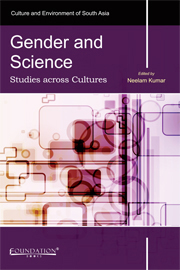Book contents
- Frontmatter
- Contents
- List of Contributors
- Acknowledgements
- Introduction: Reflections and Realities across Cultures
- Section I Approaches and Perspectives
- Section II Illustrative Examples
- 6 Women and Science in the Netherlands: A Dutch Case
- 7 Japanese Women Scientists: Trends and Strategies
- 8 Saudi Women: Their Role in Science and Education
- 9 Changing the Facts: Gender Dimensions of the South African Public Science System
- 10 Demographic Inertia and the Glass Ceiling in American Science (1979–2000)
- 11 Women in Science in France
- 12 Women and Science: Issues and Perspectives in the Indian Context
- Conclusion: The Persistent Patterns!
- Bibliography
- Index
10 - Demographic Inertia and the Glass Ceiling in American Science (1979–2000)
from Section II - Illustrative Examples
Published online by Cambridge University Press: 05 May 2013
- Frontmatter
- Contents
- List of Contributors
- Acknowledgements
- Introduction: Reflections and Realities across Cultures
- Section I Approaches and Perspectives
- Section II Illustrative Examples
- 6 Women and Science in the Netherlands: A Dutch Case
- 7 Japanese Women Scientists: Trends and Strategies
- 8 Saudi Women: Their Role in Science and Education
- 9 Changing the Facts: Gender Dimensions of the South African Public Science System
- 10 Demographic Inertia and the Glass Ceiling in American Science (1979–2000)
- 11 Women in Science in France
- 12 Women and Science: Issues and Perspectives in the Indian Context
- Conclusion: The Persistent Patterns!
- Bibliography
- Index
Summary
This chapter intends to document some of the fundamental changes in American women's full participation into science, changes that will have major impacts on the ‘face of science and engineering’ for decades to come. ‘Demographic inertia’ in this chapter refers to the long-term impact of combined demographic forces on women's representation in science. This chapter highlights the many dimensions of the changing representation of women in US science and engineering (S&E). Using data from two National Science Foundation (NSF) databases – the Survey of Earned Doctorates (SED) for new PhDs and the Survey of Doctoral Recipients (SDR) for the S&E doctoral workforce – it brings together data on the educational background and demographic characteristics of three decades of new PhDs and then examines their careers as described by the data. After considering changes in the percentage of PhDs to women, changes in their labour force participation, and reasons for the greater proportion of female scientists and engineers with less than full employment, I show how these changes have important implications for major career outcomes within academia. The importance of examining achievement within the context of the entire career and to understand the effects of demographic changes on movement into more advanced positions has been considered in a variety of recent studies (Hargens and Long, 2002; Long 2001; Morgan, 1998). The current chapter applies these ideas to rank advancement for women in American science. The results show that there has been a steady convergence, making the careers of men and women increasingly more similar. But, there remain consistent differences that leave women with less achievement, salary, and position.
- Type
- Chapter
- Information
- Gender and ScienceStudies across Cultures, pp. 208 - 226Publisher: Foundation BooksPrint publication year: 2012



